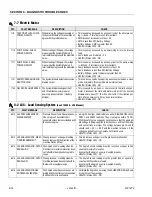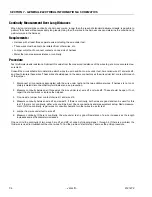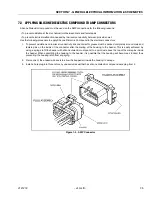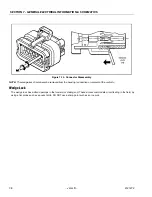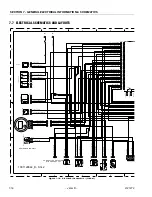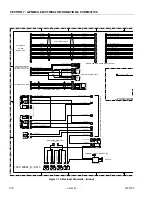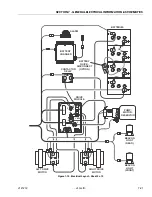
SECTION 7 - GENERAL ELECTRICAL INFORMATION & SCHEMATICS
7-12
– JLG Lift –
3121273
7.5 SWITCHES
Basic check
The following check determines if the switch is functioning properly, not the circuit in which the switch is placed. A switch
is functioning properly when there is continuity between the correct terminals or contacts only when selected.
1.
De-energize the circuit.
2.
Isolate the switch from the rest of the circuit if possible. If not possible, keep in mind it may affect readings.
3.
Access the terminals to the switch.
4.
If the switch has two terminals:
a.
Measure resistance across the terminals.
b.
Change the switch position.
c.
Measure resistance again with the leads in the same positions. If the meter was reading short, it should read an
open. If the meter was reading open it should read short.
5.
If the switch has more than two terminals, consult the schematic or switch diagram to determine what terminals will
be connected. The test is similar to testing a switch with two terminals.
a.
Place one meter lead on the common contact and the other on a different contact in the same circuit.
b.
Cycle through all positions of the switch. The meter should read short only when the switch connects the two
terminals and open otherwise.
c.
If the switch has more than one common contact repeat the process for that circuit.
Limit Switches
Limit switches are used to control movement or indicate position. Mechanical limit switches are just like manually oper-
ated switches except that the moving object operates the switch. These switches can be tested the same way as a stan-
dard switch by manually operating the sensing arm.
Another type of limit switch used by JLG is the inductive proximity switch, also referred to as a "prox switch". Inductive
proximity switches are actuated only by ferrous metal (metal that contains Iron, such as steel) near the switch. They do
not require contact, and must be energized to actuate. These types of switches can be used to detect boom or platform
position, for example. These switches have a sensing face where the switch can detect ferrous metal close to it. To find
the sensing face, take note how the switch is mounted and how the mechanisms meet the switch. Test this type of switch
as follows:
1.
Remove prox switch from its mount.
2.
Reconnect harness if it was disconnected for step a, and turn on machine.
3.
Hold switch away from metal and observe switch state in the control system diagnostics using the Analyzer. See
vehicle or control system documentation on how to do this.
4.
Place sensing face of switch on the object to be sensed by the switch. If that is not available, use a piece of ferrous
metal physically similar to it. The switch state in the control system diagnostics should change.
5.
When reinstalling or replacing switch be sure to follow mounting instructions and properly set the gap between the
switch and object sensed.

